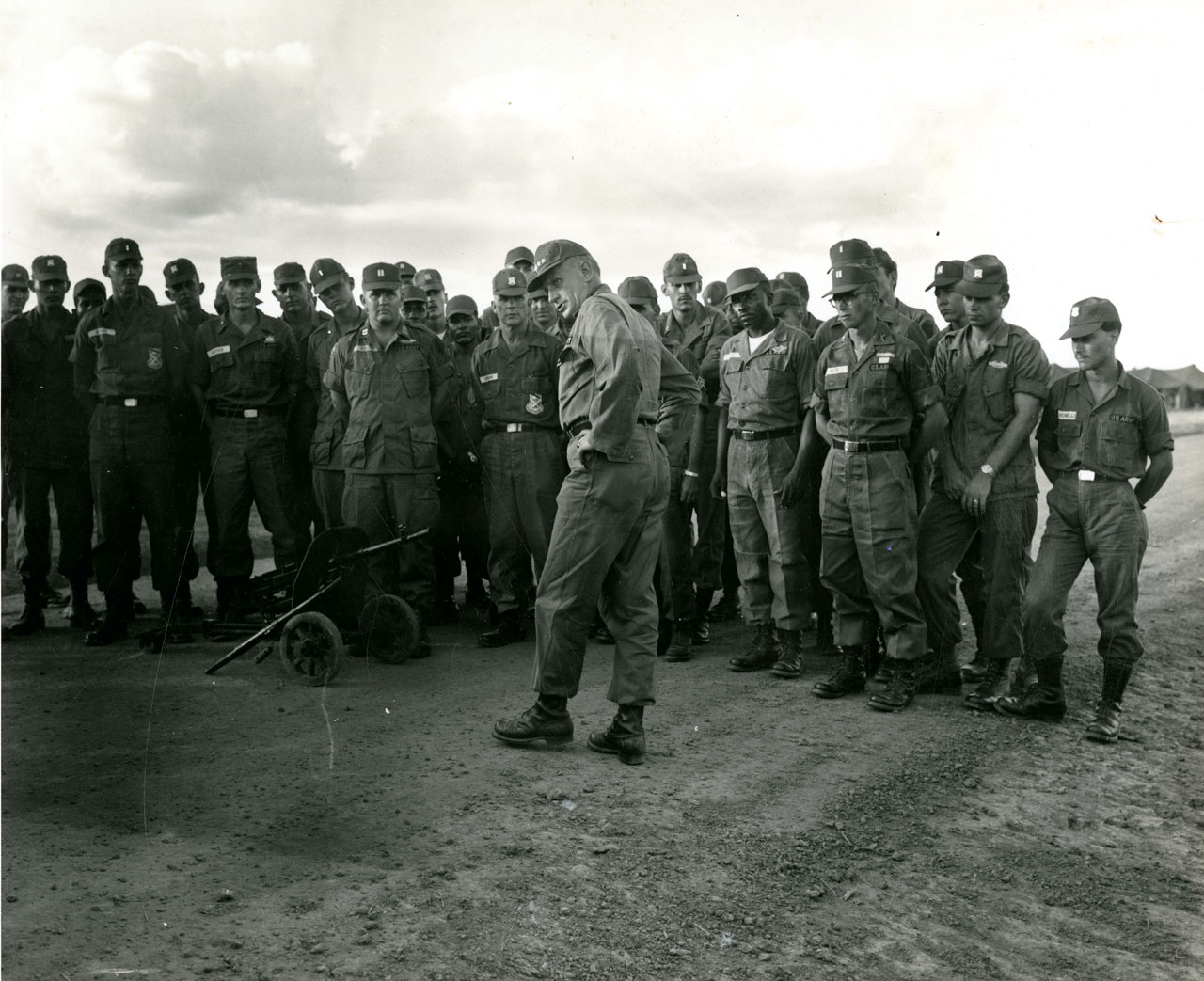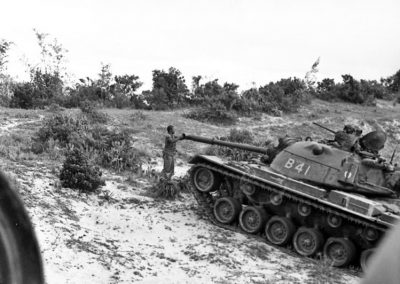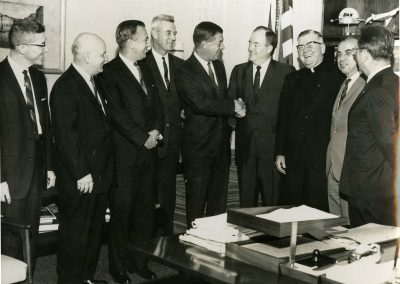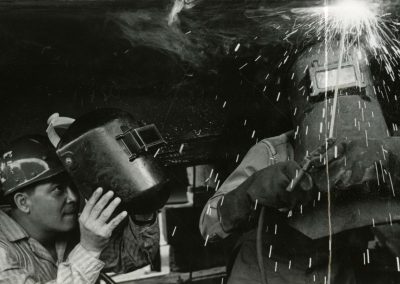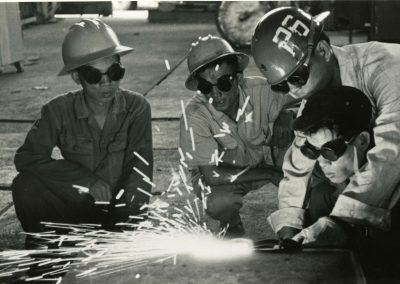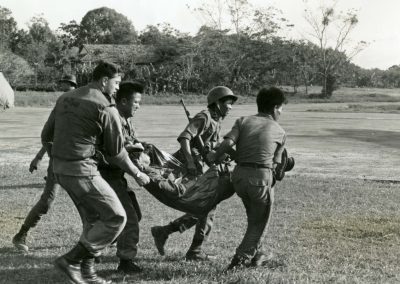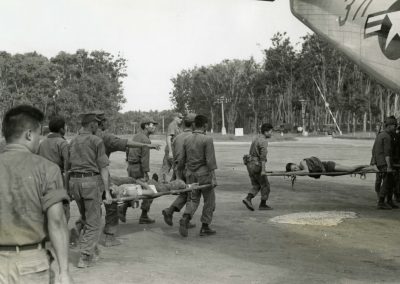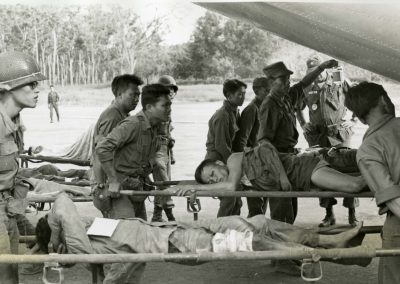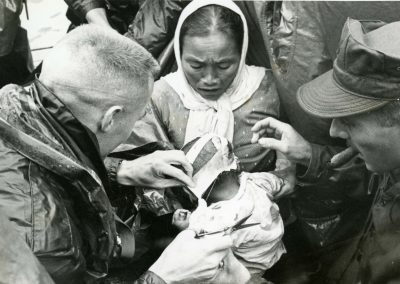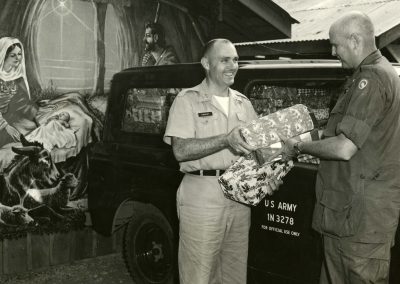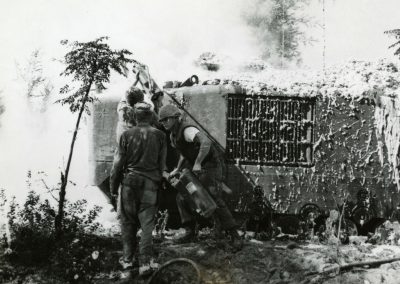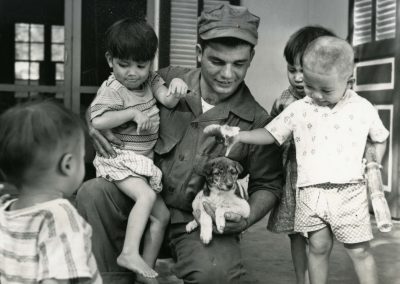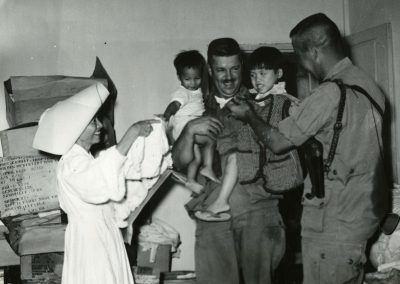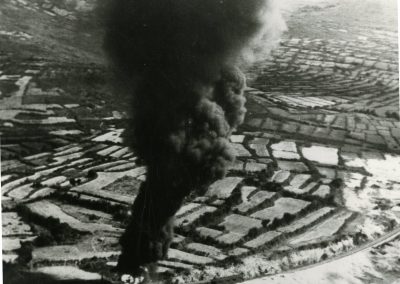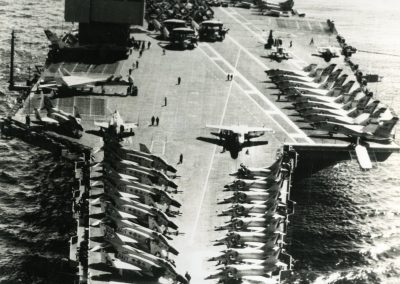The Beverly Deepe Keever Collection
Photos by Beverly Deepe Keever, 1965
Bien Hoa
Arriving in Bien Hoa, I was appalled to learn of the ferocity of the fighting that had occurred there. One U.S. veteran officer living on the gigantic base recounted, “This is the worst battlefield I have ever seen – and this is my second war.”
Harold Johnson (363-02496)
Bien Hoa, Vietnam (IO) – General Harold K. Johnson, U.S Army Chief of Staff, talks to men of the Army’s 2nd Bn, 1st Infantry Division at Bien Hoa – The 1st Div. was one of several units visited by General Johnson during his visit to Vietnam. Weapon in foreground is a Chinese Machine Gun captured by the 173rd.
Harold Johnson Rides Air Boat (363-02497)
Thuyen Nhon, Vietnam (Army IO) – General Harold K. Johnson rides an air boat used by Special Forces troops to patrol the many canals in the delta region. The Army Chief of Staff was visiting the Tuyon Nhon Special Forces camp in the 1V Corps area.
Santa Claus Propels from Helicopter (363-02498)
Saigon, Vietnam (Army IO) – Happy Vietnamese orphans wait for Santa Claus to rappel to the ground and start the Christmas party the officers and men of the 120th Aviation Company sponsored for the children. The 120th commander, Major William Chamberlin, played the part of Santa Claus.
Harold Johnson is Greeted (363-02499)
Arrival of General Harold K. Johnson, Army Chief of Staff to Vietnam. General Johnson is greeted by Maj. General W.B. Rosson, Chief of Staff, MACV at Saigon Airport, Saigon Vietnam.
Plane in Wreckage (363-03206)
Several soldiers are seen standing around planes that have landed among the Wreckage of Bien Hoa
Plane in Wreckage (363-03207)
A soldier is seen walking away from a plane landed among the wreckage of Bien Hoa
Military Operations
U.S. combat units brought with them tremendous technologies of firepower and air-power that increased the level of violence and destruction in the South. I found the cumulative impact and magnitude of allied artillery shellings and air bombardments hard to report to readers because they occurred in so many different places over sporadic stretches of time, and no official announcements about them were made.
Military Operations (363-0045)
“September 1965 – Military Operations.” A soldier looks back at the camera from the porthole of a tank. Two other tanks in the background.
Military Operations (363-0046)
“September 1965 – Military Operations.” A procession of tanks. Three men sit atop Tank B43. One soldier sits on a second tank in the background.
Military Operations (363-0047)
“September 1965 – Military Operations.” A Negro soldier in tank porthole, speaking into headset.
Military Operations (363-0048)
“September 1965 – Military Operations.” A Negro soldier in tank porthole.
Military Operations (363-0049)
“September 1965 – Military Operations.” A Negro soldier in tank porthole.
Military Operations (363-0050)
“September 1965 – Military Operations.” A soldier talking with Iht and another man outside a village of thatched-roof cottages and palm trees. A group of children watch from around a 1960 Buick.
Military Operations (363-0051)
“September 1965 – Military Operations.” Two soldiers talk with tank gunner in the background.
Military Operations (363-0052)
“September 1965 – Military Operations.” A soldier gives or recieves orders from tank gunner in the background. A second soldier runs to meet him.
Military Operations (363-0053)
“September 1965 – Military Operations.” A soldier stands on Tank B41, talking with the gunner. Another gunner sits in a second tank in the background.
Military Operations (363-0054)
“September 1965 – Military Operations.” A tank crossing an open, hilly field. A soldier’s left shoulder has obscured part of the right side of the picture.
Military Operations (363-0055)
“September 1965 – Military Operations.” A soldier adjusts the turret gun of tank B41.
Military Operations (363-0056)
“September 1965 – Military Operations.” Iht stands outside a building attached to a bridge. Marshy land leads to water in the background.
Military Operations (363-0057)
“September 1965 – Military Operations.” Four soldiers sitting on a tank in an open, hilly field.
Military Operations (363-0058)
“September 1965 – Military Operations.” The gunner of Tank B41 waiting for further instruction.
Military Operations (363-0059)
“September 1965 – Military Operations.” A Vietnamese landscape of shrubs and small hills. A tank rolls toward the right background.
Military Operations (363-0060)
“September 1965 – Military Operations.” The gunner of Tank B41 taking aim. A second soldier reaches behind the first.
Military Operations (363-0061)
“September 1965 – Military Operations.” The gunner of Tank B41 taking aim. A second soldier sits beside and watches.
Military Operations (363-0062)
“September 1965 – Military Operations.” Iht (in civilivan clothes) points at another soldier outside a thatched-roof village. A crowd of children and a third soldier among them, stand around a 1960 Buick.
Military Operations (363-0063)
“September 1965 – Military Operations.” A Negro soldier in the porthole of a tank removes his helmet.
Military Operations (363-0064)
“September 1965 – Military Operations.” Four soldiers on three tanks in formation. Tank B12 is in the middle.
Military Operations (363-0065)
“September 1965 – Military Operations.” Four soldiers on three tanks in formation. Tank B12 is in the middle. Right corner of picture is slightly obscured.
Military Operations (363-0066)
“September 1965 – Military Operations.” Four soldiers on three tanks in formation. Tank B12 is in the middle. Right corner of picture is slightly obscured.
Military Operations (363-0067)
“September 1965 – Military Operations.” Tank with seven soldiers on top approach photographer.
Military Operations (363-0068)
“September 1965 – Military Operations.” Six soldiers stand in a horseshoe, discussing some papers. Two other soldiers in background.
Military Operations (363-0069)
“September 1965 – Military Operations.” Six soldiers stand in a horseshoe, discussing some papers. Two other soldiers in background.
Military Operations (363-0070)
“September 1965 – Military Operations.” Six soldiers stand in a horseshoe, discussing some papers (one obscured). Three other soldiers in background.
Military Operations (363-0071)
“September 1965 – Military Operations.” A crowd of Vietnamese children scramble to fit into the picture Iht (in civilian clothes) is preparing to take. Two other soldiers are caught in the crowd.
Military Operations (363-0072)
“September 1965 – Military Operations.” Iht grins at the camera, surrounded by children with their hands extended. Two soldiers stand in the crowd.
Military Operations (363-0073)
“September 1965 – Military Operations.” Two Vietnamese soldiers pose for a photo. The first soldier is named “Iht.” Two children stand beside them. Behind, another soldier leans against a military jeep.
Military Operations (363-0074)
“September 1965 – Military Operations.” Iht (in civilian clothes) stands in a crowd of excited children. In the background are two military jeeps and a Vietnamese buffalo.
Military Operations (363-0075)
“September 1965 – Military Operations.” Iht walking along a country path, looking back at photographer. A woman wearing a coolie hat also walks on the path, carrying two bales of hay on a yolk across her shoulders. Buildings line the horizon.
Military Operations (363-0076)
“September 1965 – Military Operations.” Iht listening to group of children. Behind him are two other soldiers. In the background are two military jeeps and a Vietnamese buffalo.
Military Operations (363-0077)
“September 1965 – Military Operations.” Iht (in civilian clothes) stands in front of a building. Behind him stands an older man in traditional Vietnamese garb.
Military Operations (363-0078)
“September 1965 – Military Operations.” Iht stands in the road amid a large group of children. Tall, tropical plants line the road.
Military Operations (363-0079)
“September 1965 – Military Operations.” Five tanks in a hilly field. The center tank is opened at the rear, revealing more soldiers inside.
Military Operations (363-0080)
“September 1965 – Military Operations.” Five tanks in a hilly field. The center tank is opened at the rear, revealing more soldiers inside.
Military Operations (363-0081)
“September 1965 – Military Operations.” Three soldiers run through a field, a tank to their right. The field is edged by a forest. Vague outlines of mountains rest on the horizon.
Military Operations (363-0082)
“September 1965 – Military Operations.” Two tanks in the brush. Photo taken from atop the second tank. A Negro soldier works from this tank.
Military Operations (363-0083)
“September 1965 – Military Operations.” Two soldiers atop Tank B12. A third soldier’s head partially obscures the picture.
Military Camp
The marines had transformed swampland, weeds, debris, and six structures into a city of tents, wooden frame toilets, a flimsy canvas shower hall, their own water purifying system, a fuel field, a seventy-five-kilowatt electric plant, and a thousand foot, all weather runway, equipped with portable lights. “This is just a typical marine operation,” [Colonel] Carey said offhandedly.
Soldier (363-02840)
Soldier is smoking what appears to be a cigar as he walks towards the camera. A military camp/base appears to be in the background.
Soldier (363-02841)
Soldier appears to be preparing to smoke a cigar. A military base/camp appears to be in the background
Group of Soldiers (363-02843)
A group of soldiers are standing in plumes of smoke outside a tent for what appears to be for a meal time.
Soldiers At Table (363-02844)
A group of soldiers is sitting at a table in the middle of what appears to be a military base/camp.
Soldiers Sitting (363-02845)
Three soldiers are sitting on the ground near some small trees. A fourth soldier is seen leaning against a tree in the background.
Soldiers Around Map (363-02848)
A group of soldiers are standing/kneeling around what appears to be a map.
Soldiers Around Map (363-02849)
A group of soldiers are standing/kneeling around what appears to be a map.
Soldiers on Path (363-02852)
Two soldier are seen on a road/path. One is kneeling in the foreground as the other is seen running in the background.
Soldiers on Path (363-02854)
Two soldiers are seen on some path/road. The soldier in the foreground is kneeling and other in the background is standing.
Soldiers on Path (363-02855)
Two soldiers are seen walking along some path/road. The two soldiers are ahead the photographer.
African American Soldier (363-02858)
A photograph of an African America soldier is taken as he walks through what appears to be his camp/base.
Soldier (363-02859)
A soldier is seen walking around a base/camp carrying some weapons. A jeep is seen in the background.
Soldiers (363-02860)
Soldiers are seen to be gearing up. Two soldier appear to be attaching something to a third soldiers back. Other soldiers are seen in the background.
Soldiers (363-02861)
Three soldiers have their photo taken. Other soldiers are seen in the background.
Soldiers Playing Volleyball (363-02865)
A group of soldiers are seen readying for a game of volleyball.
Make Shift Theater (363-02866)
Three soldiers are seen standing near what appears to be a make-shift theater located in a base camp.
Playing Chess (363-02867)
Two soldiers are seen sitting under a tent like structure playing a game of chess.
Tent Lines (363-02868)
Rows of tents are pictured. The tents are put in several rows within some trees.
Soldier in Camp (363-02872)
A soldier is seen standing near tents and a laundry line within his camp.
Soldiers in Camp (363-02874)
Several soldiers are photographed while in their camp. More soldiers are seen within the background.
Soldier in Camp (363-02876)
A soldier is pictured in his camp behind a tent. He appears to be holding a stick.
Soldier with Supplies (363-02878)
A soldier is photographed in his camp some supplies in a box are seen at his feet. He also appears to be holding something in his hand.
Soldier with Supplies (363-02879)
A soldier is photographed in his camp some supplies in a box are seen at his feet. He also appears to be holding something in his hand.
Soldier in Trench (363-02881)
A soldier is photographed standing in a sandbag trench, he is also standing next to a large weapon/gun which is propped against the sandbag structure.
Soldier in Trench (363-02882)
A soldier is photographed standing in a sandbag trench, he is also standing next to a large weapon/gun which is propped against the sandbag structure.
Soldier in Tank (363-02883)
A soldier is pictured in a tank. He appears to be looking through the scope. Other soldiers are surrounding the tank.
Hammock (363-02884)
A soldier is relaxing in a hammock, other soldiers are seen talking to him as the photo is taken.
Hammock (363-02885)
A soldier is relaxing in a hammock in his camp. He appears to be reading something.
Soldier Near Covered Trench (363-02886)
A soldier is photographed near an open trench. The trench appears to have a cover to hide the trench.
Soldier Near Covered Trench (363-02887)
A soldier is photographed near an open trench. The trench appears to have a cover to hide the trench.
Soldiers on Road (363-02891)
Soldiers are photographed walking along a road towards a sandbag structure.
Soldiers on Road (363-02892)
Soldiers are photographed walking along a road towards a sandbag structure.
McNamara
As then secretary of defense Robert McNamara, a key architect of Kennedy’s policy, wrote later, the Vietnam War was to become “among the bloodiest in all of human history.”
Tan Son Nhut
Tan Son Nhut, just about the world’s busiest and best-defended airport and site of the headquarters of Westmoreland’s command, was subjected to pitched battles, mortar fire, sniper siege, and guerilla raids. Communists donning government soldiers’ fatigues attacked the South Vietnamese High Command.
Armament Specialist (363-02456)
Hq 2AD Tan Son Nhut afld – RVN – Armament Specialist – U.S. Air Force A2C Ross J. Nicholson, of Grove City, Pa., a U.S. Air Force armament specialist, works on the hot gun bay of a North American F-100 Aupersabre of the 481st Tactical Fighter Squadron, Airman Nicholson is loading 20mm cannon shells in the Supersabre for a sortie somewhere in the Republic of Vietnam.
Cabin Secure (363-02457)
Hq 2AD Tan Son Nhut – Cabin Secure – U.S. Air Force A2C William R. Rumsey of 3109 Valley View, Dallas, Tex., a C-130 Hercules loadmaster, tells his aircraft commander, via intercom, that his cargo cabin is secure. This photo was shot just prior to takeoff from Pleiku Airfield, Republic of Vietnam.
Adding Hydraulic Fluid (363-02458)
Hq 2AD Tan Son Nhut – Inflight – U.S. Air Force A2C John H. Paxton of RT. 4, box 23, Glendenin, Va., adds hydraulic fluid to the hydraulic system of his lockhead C-130 Hercules. At the time, Airman Pacton, maintenance crew chief of his aircraft was on a flight over the Republic of Vietnam.
Unloading Bombs (363-02475)
Hq 2AD Tan Son Nhut Afld, RVN – U.S. Air Force B-52 Stratofortressesses of the Strategic Air Command unload tons of bombs on a strike against the notorious Viet Cong hideway, Zone D, during a July raid.
Ban Nuoc Chieu (363-02482)
A U.S. Air Force aerial reconnaissance photo of the Ban Nuoc Chieu ammunition depot, 80 miles west-northwest of Hanoi, shows heavy damage inflicted by U.S. Air Force Strikes in late June. This section of the target area covers about 700 by 1200 feet. Debris in the center and right side of the photo reveal areas where buildings were completely destroyed. Reports showed 22 buildings destroyed and seven others damaged during the strikes. Roadways in the target area were also heavily damaged.
Than Hoa Barracks (363-02487)
Hq 2AD, Tan Son Nhut Afld, RVN – Than Hoa Barracks – This reconnaissance photo of a U.S. Air Force stirke against North Vietnam’s Than Hoa Army Barracks (July 7) shows about half the barracks area destroyed. Large craters and debris in the upper portions of the photo are all that reamins of areas once covered by barracks buildings. Effect of bombs on highways can be seen in the lower center.
Silver Stars for MIG Kills (363-02488)
Hq 2AD, Tan Son Nhut Afld, RVN – Silver Stars for MIG Kills – Lt. Gen. Joseph H. Moore, commander of the 2d Air Division with headquarters here, awards Silver Star medals to F-4C aircraft commanders who downed two Communist MIG-type jets over North Vietnam yesterday. Accepting the awards are U.S. Air Force pilots Capt. Kenneth D. Holcombe of Detroit, Mich., and Capt. Thomas S. Roberts of LaGrange, Ga. The MIGs were the first shot down by U.S. Air Force pilots in the Vietnamese conflict.
US Air Forces First Vietnam MIG Killers Whoop It Up (363-02489)
Hq 2AD, Tan Son Nhut afld, RVN – U.S. Air Force’s First Vietnam MIG Killers Whoop It Up – Following awards of Silver Stars and Distinguished Flying Across by 2d Air Division Commander Lt. Gen Joseph H. Moore at Ten Nhut Airfield today, members of the first U.S. Air Force flight to down Communist MIG Airfield jets whoop it up. Flight Commander Maj. Richard Hall of Forest Lake, Minn., gets a ride to the shoulders of other members of the flight, 1. 1st Lt. George Larson of Winter Haven, Fla.; Capt. Ronald C. Anderson of Fairbanks, Alaska; Capt. Kenneth D. Holcombe of Detroit, Mich,; Capt. Thomas Roberts of LaGrange, Ga.; Capt. Harold Anderson of Yucaipa, Calif.; Major Hall; Capt. Arthur C. Clark of McAllen, Tex., and Capt. Wilbur Anderson of Tarboro N.C.
Dien Bien Phu Runway (363-02490)
Hq 2AD, Tan Son Nhut Afld, RVN – Dien Bien Phu Runway – July strikes against the Dien Bien Phu airfield in North Vietnam by U.S. Air Force Republic F-105s and McDonnel F-4s have left the airfield runway unusable. A direct hit (lower left) and several other 750 pound bomb blasts )center_ effectively cratered the airstrip.
Supply Route Cut (363-03210)
Hq 2AD Tan Son Nhut Afld RVN – Supply Route Cut – A flight of four U.S. Air Force F-105 Thunderchiefs knocked out one span of the Vinh Tuy Highway Bridge on Aug. 11. After cutting the Communist supply route, the F-105 piloted by Capt. Lawerence D. Wilson of Cleveland, Ohio, was downed by anti-aircraft fire. Captain Wilson ejected from his aircraft was rescued from the Gulf of Tonkin by an HU-16 Albatross.
Davis and Duchess (363-03211)
Hq 2AD Tan Son Nhut Afld, RVN – Plucky Sentry dog – Duchess, a U.S. Air Force sentry dog poses with her handler. A2C Clifford F. Davis of Knoxville, Tenn. The German Shepard probably saved Airman Davis’ life last week when she tooks a bite from a krait snake in tall grass while on patrol. Krait bites are fatal to humans in almost every instance, but the plucky sentry dog survived and is back on duty.
Plei Me
“In my opinion, the Air Force has saved this camp…air strikes outstanding.” These are the words of the Plei Me Special Forces outpost commander, Captain Harold M. Moore. His camp has been under attack by a multi-battalion sized Viet Cong Force since 7:00 P.M., 19 Oct. It all started with a 20 to 40 man VC probe of the outpost’s defenses. Since then it has blossomed into a major battle in which air power has played a role of tremendous importance.
Helicopters Landed in Field (363-1172)
“Plei Me – Bak To Oct 65” ; “A line of landed helicopters lay sit in a field.”
Damages
“It was becoming necessary to destroy the town to save it,” the major [Peter Arnett] was quoted as saying. Returning to Saigon, Arnett focused his copy on that memorable quote, which, he recounted, “leaped out as a comment on the essential dilemma of the Tet Offensive. The authorities had not only to defeat the attackers, but protect the civilian population.”
1965/66 (363-0617)
Original caption: “1965/66” Two men walk through the rubble of a city. In the foreground, a 1960 Volkswagon Beetle is covered with rubble and torn fabric.
1965/66 (363-0618)
Original caption: “1965/66” A man in uniform climbs over a ruined 1960 Volkswagon Beetle. Rubble and torn fabric litter the street.
1965/66 (363-0619)
Original caption: “1965/66” A group of men in uniform arrive outside a ruined building with a truck filled with supplies.
1965/66 (363-0620)
Original caption: “1965/66” A man in uniform outside a ruined building, perhaps unloading something. The blurred face of another man obscures most of the picture.
1965/66 (363-0621)
Original caption: “1965/66” A group of men in uniform arrive outside a ruined building with a truck filled with supplies.
Navy Photos
Hamlet residents along a river in Ba Xuyen and Chuong Thien Provinces were increasingly reluctant to travel the waterways after U.S. Navy boats began patrolling the area, one American in the field learned in 1966, thanks to U.S. polling of Vietnamese nationwide.
Swift Ships on Christmas (363-02622)
SWIFTS boats try-out their sea legs upon arrival in Vietnam. Six SWIFTs arrived on Christmas Eve to join two others in Operation Market Time patrols off Phu Quoc Island in the Gulf of Thailand. Manned by U.S. Navy crews, these boats will patrol in conjunction with other Market Time unit to prevent inflitrations of men, arms and equipment by the Viet Cong.
Coast Guard Cutter (363-02828)
Coast Guard Cutter – Wearing a war zone coat of gray paint over her standard coat of white, the Coast Guard Cutter Point Grey operates on patrol out of An Thoi, Phu Quoc island, in the Gulf of Thailand. Seventeen cutters have been operating as units of the Coastal Surveillance Force since July of 1965, eight in Da Nang and nine in An Thoi.
Swift (363-02829)
Swift – Capable of speeds in excess of 25 knots, this 50-footer is aptly named the SWIFT. It mounts a twin .50-cal. Machine gun atop the pilot house and carriers a dual-mount combination, .50-cal machine gun and 81mm mortar aft. The first SWIFTS arrived in South Vietnam on Oct. 31, 1965, when they went on patrol out of An Thoi, Phu Quoc Island, as units of the Coastal Surviellance Force, engaged in preventing the inflitration of men, arms and supplies into the country for the Viet Cong.
Swift (363-02830)
Swift – Capable of speeds in excess of 25 knots, this 50-footer is aptly named the SWIFT. It mounts a twin .50-cal maching gun atop the pilot house and carriers a dual-mount combination .50 cal. Machine gun and 81mm mortar aft. The first SWIFTs arrived in South Vietnam on Oct. 31, 1965, when they went on patrol out of An Thoi, Phu Quoc Island, as units of the Coastal Surveillance Force, engaged in preventing the inflitration of men, arms and supplies into the country for the Viet Cong.
First Aid (363-02831)
First Aid – A. U.S. Coast Guardsman administers first aid to a Vietnamese civilian junkman during an inspection of his junk in the Gulf of Thailand. Serving as units of the Coastal Surveillance Force, the Coast Guard cutters are presently engaged in preventing in the infiltration by sea of men, arms and supplies for the Viet Cong.
Cargo Check (363-02832)
Cargo Check – A Vietnamese civilian junk is searched by a Vietnamese Navy liaison officer and crewmembers of a U.S. Coast Guard cutter during a patrol in the Gulf of Thailand. The Coast Guard cutters are based at An Thoi, Phu Quoc Island and operate as units of the Coastal Surveillance Force.
Speaking to Crew (363-03196)
RADM James R Reedy, USN, Commander Task force 77 looks on as Admiral David L. MacDonald USN, Chief of Naval Operations speaks to the crew of the USS Independence
On a Bridge (363-03197)
RADM James R Reedy, USN, Commander Task Force 77 looks on as Admiral David L. MacDonald USN, Chief of Naval Operations, on the bridge of the USS Indpendence
On a Tour (363-03198)
Adm. David L MacDonald USN, Chief of Naval Operations is greeted by Capt. John E. Kennedy C.O. of the USS Independence. Adm MacDonald and his party are on a tour of naval ships and installations in the South China Sea and Vietnam.
Greeted (363-03199)
Adm. David L MacDonald USN, Chief of Naval Operations steps down from C1A/ IR- craft after landing on board the USS Independence. He is greeted by Ens. Richard E. Newbert UNSR, Air Traffic Officer
Greeted (363-03200)
RADM, James R. Reedy USN, Commander carrier task force 77 greets, Adm. David L. MacDonald USN, Chief of Naval Operations on the flight deck of the USS Independence. Vadm Paul Blackburn Commander 7th Fleet and Vadm Paul E. Ramsey are in background.
Cutting the Cake (363-03201)
During his visit to the Seventh Fleet flagship Oklahoma City Adm. David L. MacDonald, Chief of Naval Operations, cuts a cake commemorating his 59th birthday. The four-star Navy boss is touring Navy and Marine Forces in the Pacific.
Visit (363-03202)
Adm. David L. MacDonald, U.s Chief of Naval Operations, (L) is greeted by Vice Adm. Paul P. Blackburn, Jr., Commander Seveth Fleet, on the flagship Oklahoma City. During his 10-day tour of Navy and Marine forces in the Pacific, Adm. MacDonald made an overnight visit 12 Sept. to the fleet commander and his flahship.
Plane in Wreckage (363-03206)
Several soldiers are seen standing around planes that have landed among the Wreckage of Bien Hoa
Plane in Wreckage (363-03207)
A soldier is seen walking away from a plane landed among the wreckage of Bien Hoa
Amphibious Operation
Eight days after my article was published in New York, the Pentagon, also recognizing that guided missiles could not protect the Danang airbase from guerrilla attacks, ordered 2,000 men of a U.S. Marine amphibious brigade to swarm ashore near Danang.
Navy/Marine Amphibious Operations (363-01269)
Navy/Marine Amphibious Operations photos, 2, front. Caravan of tanks winding up hilly Huey coast.
Navy/Marine Operations (363-01270)
Navy/Marine Amphibious Operations photos, 2, back. Information on Operation.
Navy/Marine Operations (363-01271)
Navy/Marine Amphibious Operations photos, 3. Soldiers gathering on the shore.
Navy/Marine Amphibious Operations (363-01272)
Navy/Marine Amphibious Operations photos, 4. Troops running from ships onto shore.
Navy/Marine Amphibious Operations Photos (363-01273)
Navy/Marine Amphibious Operations photos, 5, front. A ship cruising beside a line of small boats. Another small boat is in the foreground.
Military Vehicles
Now Americans were calling it the “War of the Prairies.” The advisor told me that more Communist units, better equipped and led, were infiltrating, with command posts in the rear using telephones to their frontline troops. Most units were composed of teenaged northerners, like the private I had reported on eight months earlier but the Pentagon had denied. “These are regular units using regular inafntry tactics,” the advisor summed up. “We aren’t fighting guerrillas anymore.”
Soldiers in Camp (363-03178)
Several soldiers are seen either loading/unloading a military vehicle in camp
Soldiers in Camp (363-03179)
Several soldiers are seen either loading/unloading a military vehicle in camp
Soldiers in Camp (363-03180)
Several soldiers are seen either loading/unloading a military vehicle in camp
American Aid
[T]he number of of U.S. troops began to soar from 20,000 for advising and support roles to 184,314 in combat by the end of 1965.
Hubert Humphrey (363-02555)
Washington – Vice President Hubert H. Humphrey greets members of the Voluntary Relief Agencies Team, requested by President Lyndon B. Johnson to examine the refugee situation in Vietnam, Coordinator for the team is George Goss, of the U.S. Agency for International Development, shown shaking hands with the Vice President. The team arrived in Saigon on Monday. Shown above, left to right are: Dr. Willard Krabil, Mennonite Relief; Ugo Carus Member, Advisory Commission on voluntary Foreign Aid; Judge R. Hansen, Vice President CARE; Hugh Farley, Church World Service; John McCarthy, Catholic Relief Service; Bernard Confer, Executive Secretary, Lutheran War Relief; john Whitehead, Treasurer, International Rescue Committee.
Southworth (363-02564)
Commander Harry B. Southworth of Mexico, New York receives the Silver Star for the first successful destruction of a surface-to-air missile site in North Vietnam. (right) Rear Admiral al James R. Reedy, Commander Attack Carrier Striking Force, Seventh Fleet made the presentation.
Take Five (363-02898)
“Take Five” – Mr. Melvin Werner (center), a welder with the U.S. Naval Shipyard, Pearl Harbor, Hawaii, and two Vietnamese welders with the Saigon Naval Shipyard relax for a few minutes between periods of instructions on better welding techniques. Mr. Werner and three other welders from the Naval Shipyard at Pearl Harbor, currently on a six weeks tour under the United States Military Assitance Program, are teaching welding techniques to Vietnamese welders at the Saigon Naval Shipyard. They will return to Pearl Harbor on 12 December.
Running a Bead (363-02899)
Running A Bead – Mr. Melvin Werner (left), a welder with the U.S. Naval Shipyard, Peral Harbor, Hawaii, keeps a close eye on a Vietnamese welder running a bead with an arc-welder on the underside of a medium landing craft (LCM) at the Saigon Naval Shipyard. Mr. Werner and three other welders from the Naval Shipyard in Pearl Harbor, currently on a six weeks tour under the United States Military Assitance Program, are teaching welding techniques to Vietnamese welders at the Saigon Naval Shipyard. They will return to Pearl Harbor on 12 December.
Technical Tips (363-02900)
Technical Tips – Mr. Ruberto Bontog (second from left), a welder with the U.S. Naval Shipyard, Pearl Harbor, Hawaii, is shown giving tips in the art of metal cutting with an acetylene torch to Vietnamese welders at the Saigon Naval Shipyard in Pearl Harbor, currently on a six weeks tour under the United States Military Assitance Program, are teaching welding techniques to Vietnamese welders at the Saigon Naval Shipyard. They will return to Pearl Harbor on 12 December.
Rush Wounded Soldier (363-02904)
Saigon – MACV IO – Comrades rush a wounded friendly soldier to evacuation aircraft following fierce fighting 45 miles North-North-West of Saigon recently.
Loading Casualties (363-02905)
Saigon – Casualties suffered during a large encounter with Viet Cong forces in the Michelin Plantation area are loaded aboard a C-123 for evacuation
Loading Casualties (363-02906)
Saigon – Casualties suffered during a large encounter with Viet Cong forces in the Michelin Plantation area are loaded aboard a C-123 for evacuation
Dressing Child’s Head (363-02908)
Better than bullets – Navy Doctor Jerry A. Shields dresses a Vietnamese child’s head after treating her for an abscess. Her mother looks on, surrounded by Marines. The “clinic” is an amphibious tractor from the 1st Amphibian Bn., 3rd Marine Division. Twice a week amtracs visit a sampan community on the Han River at Da Nang to take medical help to the people, most of whom have never before received any medical treatment. Says a veteran Marine: “This sure beats bullets as a way to win, and it’s so much more lasting.
Presents for the Wounded (363-02909)
Saigon – Stacking gifts from Texas literally to the roof of their vehicle, Army Chaplains (Capt.) Fred Hanley (Boston, Mass.) and (Lt. Col.) Edwin F. Hall, Jr. (Pomona, Calif.) prepare to distribute them to patients in U.S. Army hospitals facilities in Saigon area. The presents were contributed and sent to the 1st Logistical Command in Vietnam by the Plymouth Park Baptist Church in Irving, Tex. Priority in the distribution was given to patients admitted so recently their mail from home had not “caught up.”
Amphibious Tractor Burned (363-02910)
Baked Alaska – That’s how a Marine Aircraft Group fire fighter described this amphibious tractor which hit a Viet Cong mine and burned five miles south of the Marble Mountain Air Facility, near Da Nang. Rounds of mortar shells and grenades inside did not explode due to the crash crew’s fast response.
Presenting a Puppy (363-02911)
Ah, How About a Smile – A new puppy given to the children of the Sacred Heart Orphanage in Da Nang appears somewhat disenchated with all the attention. Perhaps he would rather be off in some corner chewing on a big bone. Presenting the dog to the children is Marine Lance Corporal William Houllett (Jacksonville, Fla.) a member of the Marine Air Groupd 16 Crash Crew.
B-52 Raid
After a B-52 raid troops would have to wait thirty minutes before the dust settled enough for [Capt. Gerald L. Harington] to assess the bomb damage in the target area. “If you’ve seeen the World War II pictures of London and Berlin,” he said, “a B-52 gives you the same impression, except they’re not in the cities.”
B-52 Raid (363-0624)
“B-52 Raid – Q. Tri – Aug 1965” An aerial view of the ground. Land dotted with trees and buildings stand in the shadow of mountains. The door of an airplane can be seen on the left.
B-52 Raid (363-0625)
“B-52 Raid – Q. Tri – Aug 1965” An aerial view of the ground. Land dotted with trees and buildings stand in the shadow of mountains. A river winds through the landscape. The door of an airplane can be seen on the left.
B-52 Raid (363-0626)
“B-52 Raid – Q. Tri – Aug 1965” An aerial view of the ground. Land dotted with trees and buildings stand in the shadow of mountains. A river winds through the landscape. The door of an airplane can be seen on the left.
B-52 Raid (363-0627)
“B-52 Raid – Q. Tri – Aug 1965” An aerial view of the ground. People can be seen walking along the dirt road. A cloud of smoke or perhaps dust drifts in the upper right corner.
B-52 Raid (363-0628)
“B-52 Raid – Q. Tri – Aug 1965” An aerial view of the ground. The wide leaves of a group of shrubs bend in the wake of the airplane from which the photo was taken.
B-52 Raid (363-0629)
“B-52 Raid – Q. Tri – Aug 1965” The ground and some shrubs. White flecks in the upper right corner are photo damages.
B-52 Raid (363-0630)
“B-52 Raid – Q. Tri – Aug 1965” The ground and some shrubs. A man’s left foot can be seen in the bottom right corner. White flecks in the upper right corner are photo damages.
B-52 Raid (363-00631)
“B-52 Raid – Q. Tri – Aug 1965” A wide row of soldiers standing along the rim of a large crater. Mountains rise up from the background.
B-52 Raid (363-0632)
“B-52 Raid – Q. Tri – Aug 1965” A wide row of soldiers standing along the rim of a large crater. (Damaged.)
B-52 Raid (363-0633)
“B-52 Raid – Q. Tri – Aug 1965” A wide row of soldiers standing along the rim of a large crater. Mountains rise up from the background.
B-52 Raid (363-0634)
“B-52 Raid – Q. Tri – Aug 1965” A wide row of soldiers standing along the rim of a large crater. Mountains rise up from the background.
Aerial Photos
By launching its destructive bombing campaign against North Vietnam, the United States was trying to rescue South Vietnam. But the U.S. combat units and increased firepower were no substitute for a legitimate, stable government worthy of popular support within the United States and South Vietnam.
A4 Skyhawk (363-02485)
A U.S Navy A4 Skyhawk from the Seventh Fleet carrier USS Bon Homme Richard drops a napalm bomb during operations against the Viet Cong on July 1 southeast of Saigon. Pilot of the aircraft was Ens R. W. Nielson of Sacremento, Calif.
A4 Skyhawk (363-02486)
A U.S. Navy A4 Skyhawk from the Seventh Fleet carrier USS Bon Homme Richard pulls away as a napalm bomb explodes during action against the Viet Cong on July 1 southwest of Saigon. Pilot of the aircraft was Ens. R. W. Nielson of Sacremento, Calif.
Dong Hoi Barracks (363-02492)
Aerial reconnaissance of a section of the Dong Hoi army barracks, located 35 miles north of the demarcation line, shows some of the heavy damage inflicted by a joint USAF and VNAF stirke force. Eight VNAF A-1H and four USAF F-104s struck the target with 27 tns of 50 to 500 pound general bombs rockets. Reports showed that 80 percent of the barracks buildings, seen along the bottom and right side of the photo, were destroyed or damaged during the attack.
Aerial Photo – Train Attack (363-02403)
Smoke billows from a North Vietnamese train attacked by Seventh Fleet Aircraft from the carrier, USS Midway, May 4 in what a Seventh Fleet spokesman said was probably the most successful armed reconnaissance mission flown to date by naval aircraft over Vietnam. Twenty railroad cars and two locomotives were destroyed and left smoking. The train, headed southward was stopped by downed bridges over North Vietnam Tuesday after conducting three days of in country attacks against Viet Cong concentrations in South Vietnam. Some twelve aircraft, including A-4 Skyhawks and F-8 Crusaders, participated in the attack, hitting the train with 250 pound bombs, five inch zuni rockets and 20mm gunfire.
Aerial Photo – Xom Ca Trang Bridge (363-02404)
Xom Ca Trang bridge on route 12, 40 miles south of Vinh, at 12:30 today. The 2nd aircraft of the strike group scored a direct hit, dropping 1 span of the 2 span structure.
Aerial Photo – USS Enterprise (363-02405)
The nuclear powered aircraft carrier USS Enterprise became a member of the U.S Seventh Fleet today. Accompanying her was the nuclear powered guided missile frigate USS Bainbridge.

